ACR101 - Street Crime in Australia: The Impact of Increased Policing
VerifiedAdded on 2023/03/21
|7
|1723
|28
Essay
AI Summary
This essay investigates the effectiveness of increasing police numbers as a primary strategy for reducing street crime, particularly in the Australian context. While acknowledging some correlation between increased police presence and decreased crime rates, the paper argues that this approach is not always the most effective or efficient. It presents criminological perspectives that challenge the notion of solely relying on law enforcement and explores alternative strategies such as situational crime prevention (SCP) and focused deterrence policing. SCP focuses on modifying environmental factors to reduce criminal opportunities, while focused deterrence targets repeat offenders with tailored interventions. The essay concludes that a combination of strategies, including addressing socio-economic factors, is more effective in achieving sustainable crime reduction than simply increasing police numbers. Desklib offers a wealth of resources, including past papers and solved assignments, to support students in their academic endeavors.

Street Crime 1
STREET CRIME
By (Student’s Name)
Professor’s Name
College
Course
Date
STREET CRIME
By (Student’s Name)
Professor’s Name
College
Course
Date
Paraphrase This Document
Need a fresh take? Get an instant paraphrase of this document with our AI Paraphraser
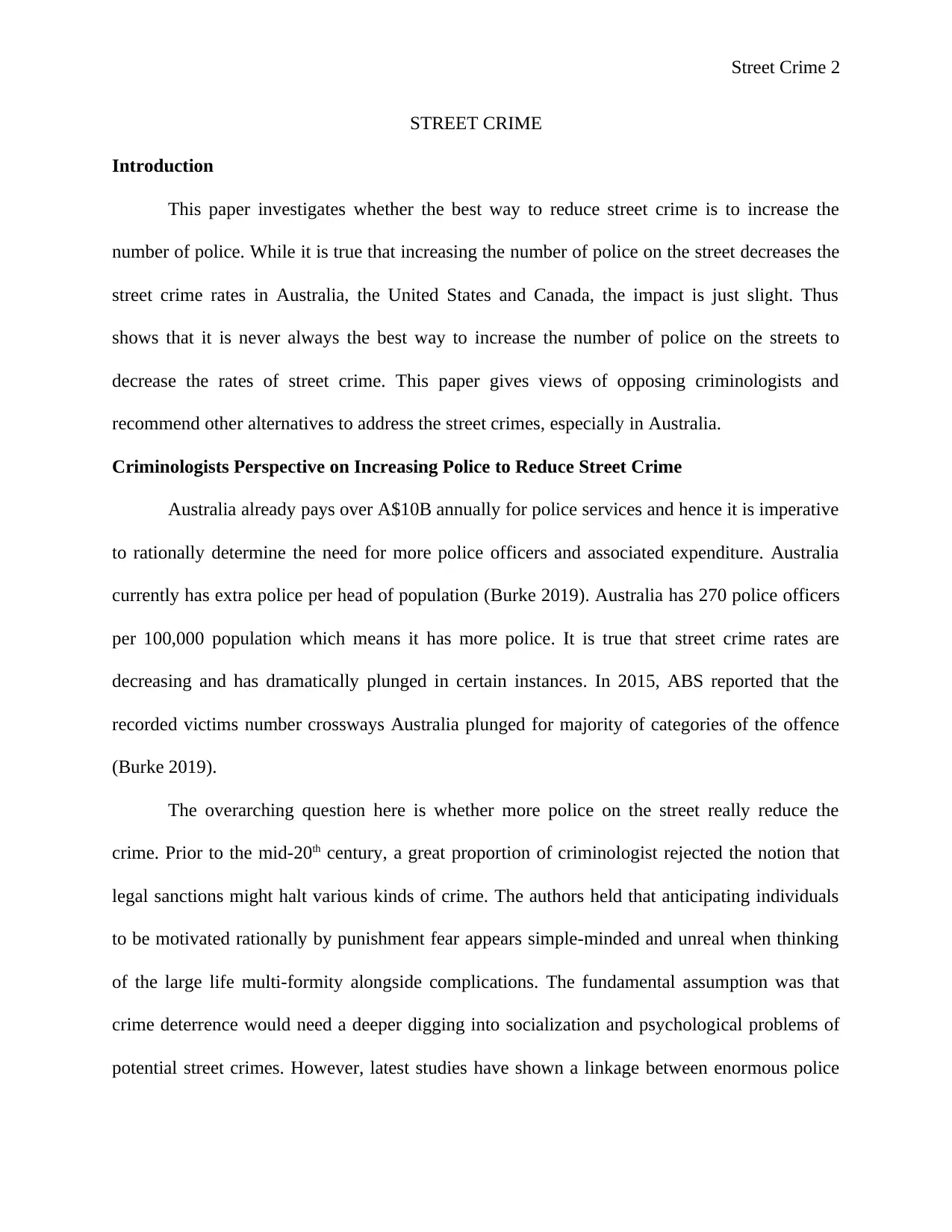
Street Crime 2
STREET CRIME
Introduction
This paper investigates whether the best way to reduce street crime is to increase the
number of police. While it is true that increasing the number of police on the street decreases the
street crime rates in Australia, the United States and Canada, the impact is just slight. Thus
shows that it is never always the best way to increase the number of police on the streets to
decrease the rates of street crime. This paper gives views of opposing criminologists and
recommend other alternatives to address the street crimes, especially in Australia.
Criminologists Perspective on Increasing Police to Reduce Street Crime
Australia already pays over A$10B annually for police services and hence it is imperative
to rationally determine the need for more police officers and associated expenditure. Australia
currently has extra police per head of population (Burke 2019). Australia has 270 police officers
per 100,000 population which means it has more police. It is true that street crime rates are
decreasing and has dramatically plunged in certain instances. In 2015, ABS reported that the
recorded victims number crossways Australia plunged for majority of categories of the offence
(Burke 2019).
The overarching question here is whether more police on the street really reduce the
crime. Prior to the mid-20th century, a great proportion of criminologist rejected the notion that
legal sanctions might halt various kinds of crime. The authors held that anticipating individuals
to be motivated rationally by punishment fear appears simple-minded and unreal when thinking
of the large life multi-formity alongside complications. The fundamental assumption was that
crime deterrence would need a deeper digging into socialization and psychological problems of
potential street crimes. However, latest studies have shown a linkage between enormous police
STREET CRIME
Introduction
This paper investigates whether the best way to reduce street crime is to increase the
number of police. While it is true that increasing the number of police on the street decreases the
street crime rates in Australia, the United States and Canada, the impact is just slight. Thus
shows that it is never always the best way to increase the number of police on the streets to
decrease the rates of street crime. This paper gives views of opposing criminologists and
recommend other alternatives to address the street crimes, especially in Australia.
Criminologists Perspective on Increasing Police to Reduce Street Crime
Australia already pays over A$10B annually for police services and hence it is imperative
to rationally determine the need for more police officers and associated expenditure. Australia
currently has extra police per head of population (Burke 2019). Australia has 270 police officers
per 100,000 population which means it has more police. It is true that street crime rates are
decreasing and has dramatically plunged in certain instances. In 2015, ABS reported that the
recorded victims number crossways Australia plunged for majority of categories of the offence
(Burke 2019).
The overarching question here is whether more police on the street really reduce the
crime. Prior to the mid-20th century, a great proportion of criminologist rejected the notion that
legal sanctions might halt various kinds of crime. The authors held that anticipating individuals
to be motivated rationally by punishment fear appears simple-minded and unreal when thinking
of the large life multi-formity alongside complications. The fundamental assumption was that
crime deterrence would need a deeper digging into socialization and psychological problems of
potential street crimes. However, latest studies have shown a linkage between enormous police
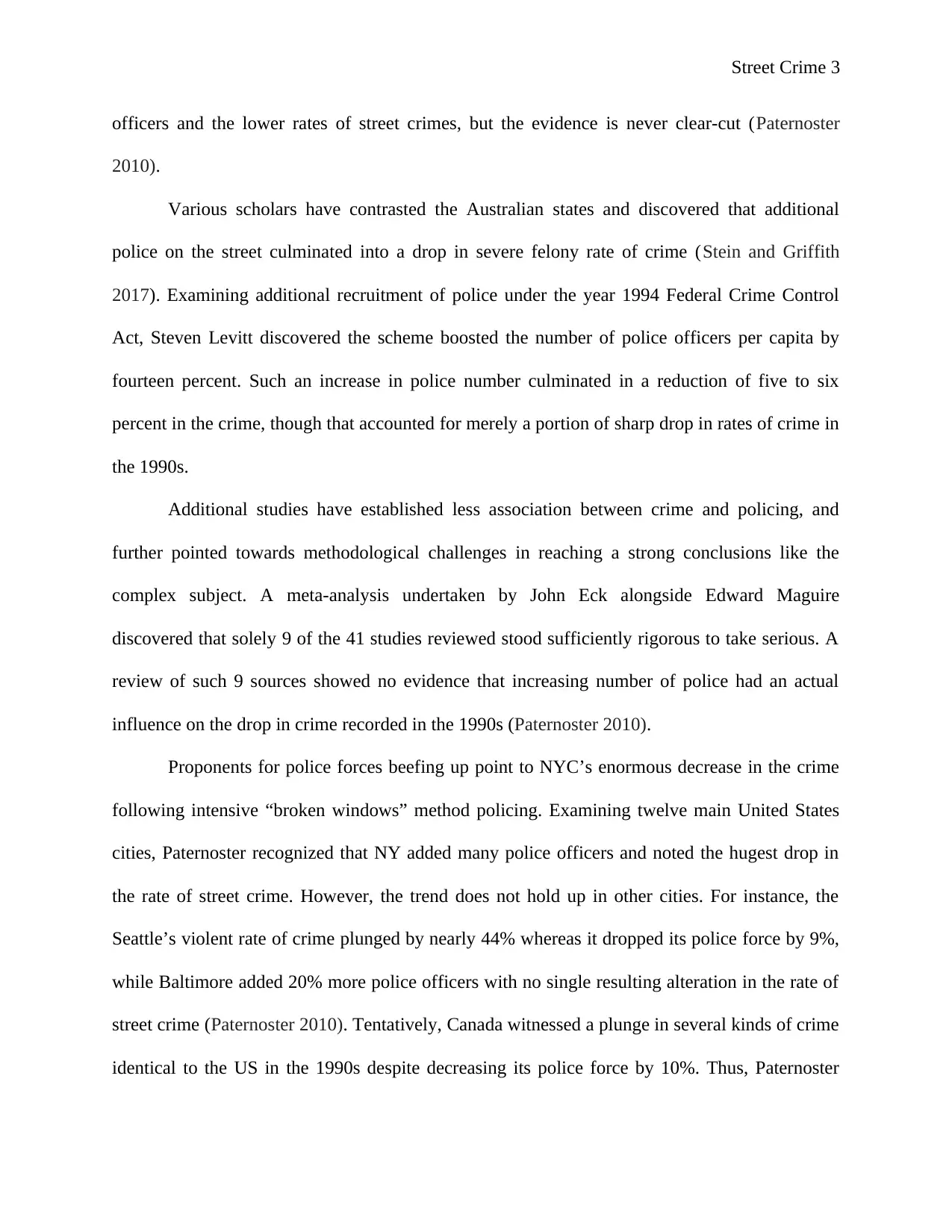
Street Crime 3
officers and the lower rates of street crimes, but the evidence is never clear-cut (Paternoster
2010).
Various scholars have contrasted the Australian states and discovered that additional
police on the street culminated into a drop in severe felony rate of crime (Stein and Griffith
2017). Examining additional recruitment of police under the year 1994 Federal Crime Control
Act, Steven Levitt discovered the scheme boosted the number of police officers per capita by
fourteen percent. Such an increase in police number culminated in a reduction of five to six
percent in the crime, though that accounted for merely a portion of sharp drop in rates of crime in
the 1990s.
Additional studies have established less association between crime and policing, and
further pointed towards methodological challenges in reaching a strong conclusions like the
complex subject. A meta-analysis undertaken by John Eck alongside Edward Maguire
discovered that solely 9 of the 41 studies reviewed stood sufficiently rigorous to take serious. A
review of such 9 sources showed no evidence that increasing number of police had an actual
influence on the drop in crime recorded in the 1990s (Paternoster 2010).
Proponents for police forces beefing up point to NYC’s enormous decrease in the crime
following intensive “broken windows” method policing. Examining twelve main United States
cities, Paternoster recognized that NY added many police officers and noted the hugest drop in
the rate of street crime. However, the trend does not hold up in other cities. For instance, the
Seattle’s violent rate of crime plunged by nearly 44% whereas it dropped its police force by 9%,
while Baltimore added 20% more police officers with no single resulting alteration in the rate of
street crime (Paternoster 2010). Tentatively, Canada witnessed a plunge in several kinds of crime
identical to the US in the 1990s despite decreasing its police force by 10%. Thus, Paternoster
officers and the lower rates of street crimes, but the evidence is never clear-cut (Paternoster
2010).
Various scholars have contrasted the Australian states and discovered that additional
police on the street culminated into a drop in severe felony rate of crime (Stein and Griffith
2017). Examining additional recruitment of police under the year 1994 Federal Crime Control
Act, Steven Levitt discovered the scheme boosted the number of police officers per capita by
fourteen percent. Such an increase in police number culminated in a reduction of five to six
percent in the crime, though that accounted for merely a portion of sharp drop in rates of crime in
the 1990s.
Additional studies have established less association between crime and policing, and
further pointed towards methodological challenges in reaching a strong conclusions like the
complex subject. A meta-analysis undertaken by John Eck alongside Edward Maguire
discovered that solely 9 of the 41 studies reviewed stood sufficiently rigorous to take serious. A
review of such 9 sources showed no evidence that increasing number of police had an actual
influence on the drop in crime recorded in the 1990s (Paternoster 2010).
Proponents for police forces beefing up point to NYC’s enormous decrease in the crime
following intensive “broken windows” method policing. Examining twelve main United States
cities, Paternoster recognized that NY added many police officers and noted the hugest drop in
the rate of street crime. However, the trend does not hold up in other cities. For instance, the
Seattle’s violent rate of crime plunged by nearly 44% whereas it dropped its police force by 9%,
while Baltimore added 20% more police officers with no single resulting alteration in the rate of
street crime (Paternoster 2010). Tentatively, Canada witnessed a plunge in several kinds of crime
identical to the US in the 1990s despite decreasing its police force by 10%. Thus, Paternoster
⊘ This is a preview!⊘
Do you want full access?
Subscribe today to unlock all pages.

Trusted by 1+ million students worldwide
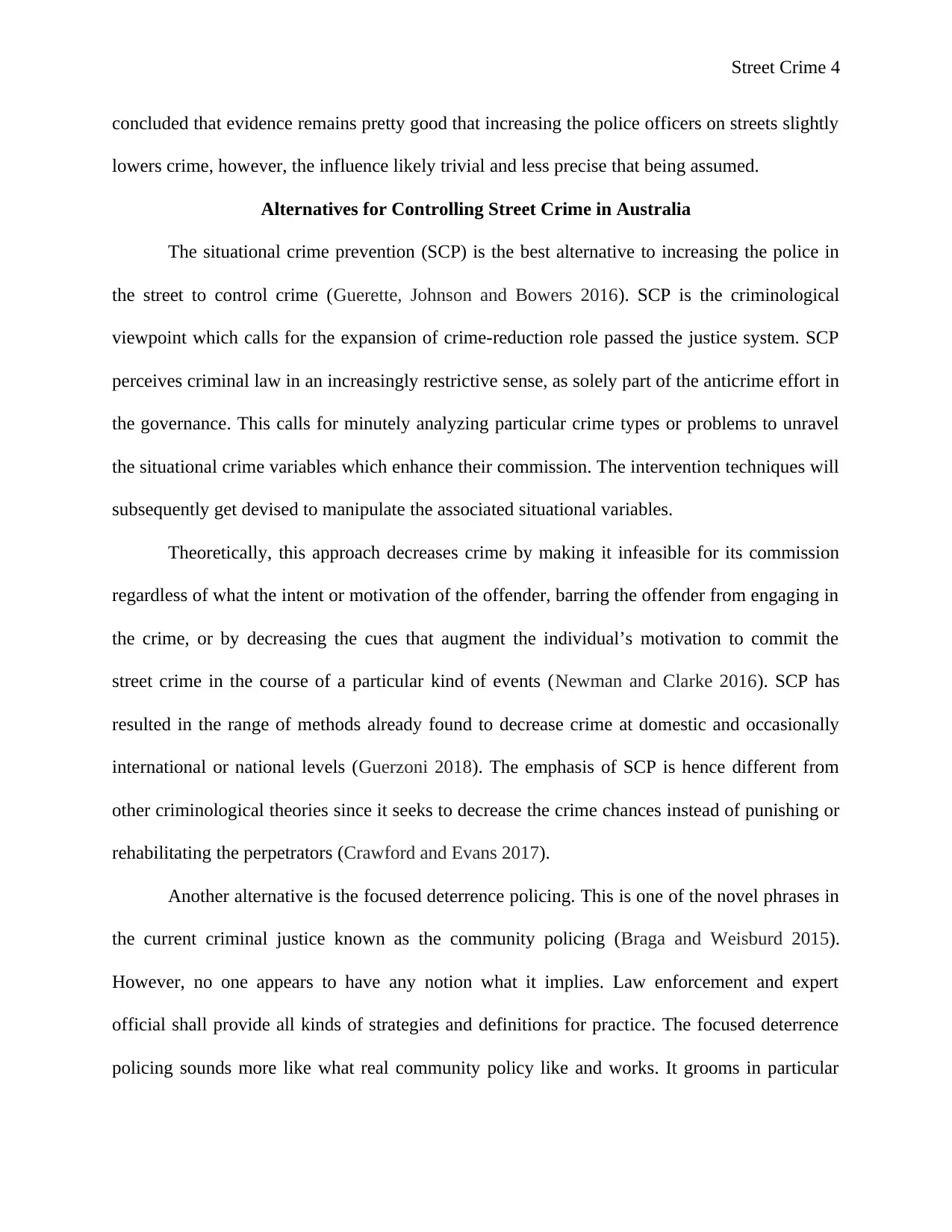
Street Crime 4
concluded that evidence remains pretty good that increasing the police officers on streets slightly
lowers crime, however, the influence likely trivial and less precise that being assumed.
Alternatives for Controlling Street Crime in Australia
The situational crime prevention (SCP) is the best alternative to increasing the police in
the street to control crime (Guerette, Johnson and Bowers 2016). SCP is the criminological
viewpoint which calls for the expansion of crime-reduction role passed the justice system. SCP
perceives criminal law in an increasingly restrictive sense, as solely part of the anticrime effort in
the governance. This calls for minutely analyzing particular crime types or problems to unravel
the situational crime variables which enhance their commission. The intervention techniques will
subsequently get devised to manipulate the associated situational variables.
Theoretically, this approach decreases crime by making it infeasible for its commission
regardless of what the intent or motivation of the offender, barring the offender from engaging in
the crime, or by decreasing the cues that augment the individual’s motivation to commit the
street crime in the course of a particular kind of events (Newman and Clarke 2016). SCP has
resulted in the range of methods already found to decrease crime at domestic and occasionally
international or national levels (Guerzoni 2018). The emphasis of SCP is hence different from
other criminological theories since it seeks to decrease the crime chances instead of punishing or
rehabilitating the perpetrators (Crawford and Evans 2017).
Another alternative is the focused deterrence policing. This is one of the novel phrases in
the current criminal justice known as the community policing (Braga and Weisburd 2015).
However, no one appears to have any notion what it implies. Law enforcement and expert
official shall provide all kinds of strategies and definitions for practice. The focused deterrence
policing sounds more like what real community policy like and works. It grooms in particular
concluded that evidence remains pretty good that increasing the police officers on streets slightly
lowers crime, however, the influence likely trivial and less precise that being assumed.
Alternatives for Controlling Street Crime in Australia
The situational crime prevention (SCP) is the best alternative to increasing the police in
the street to control crime (Guerette, Johnson and Bowers 2016). SCP is the criminological
viewpoint which calls for the expansion of crime-reduction role passed the justice system. SCP
perceives criminal law in an increasingly restrictive sense, as solely part of the anticrime effort in
the governance. This calls for minutely analyzing particular crime types or problems to unravel
the situational crime variables which enhance their commission. The intervention techniques will
subsequently get devised to manipulate the associated situational variables.
Theoretically, this approach decreases crime by making it infeasible for its commission
regardless of what the intent or motivation of the offender, barring the offender from engaging in
the crime, or by decreasing the cues that augment the individual’s motivation to commit the
street crime in the course of a particular kind of events (Newman and Clarke 2016). SCP has
resulted in the range of methods already found to decrease crime at domestic and occasionally
international or national levels (Guerzoni 2018). The emphasis of SCP is hence different from
other criminological theories since it seeks to decrease the crime chances instead of punishing or
rehabilitating the perpetrators (Crawford and Evans 2017).
Another alternative is the focused deterrence policing. This is one of the novel phrases in
the current criminal justice known as the community policing (Braga and Weisburd 2015).
However, no one appears to have any notion what it implies. Law enforcement and expert
official shall provide all kinds of strategies and definitions for practice. The focused deterrence
policing sounds more like what real community policy like and works. It grooms in particular
Paraphrase This Document
Need a fresh take? Get an instant paraphrase of this document with our AI Paraphraser
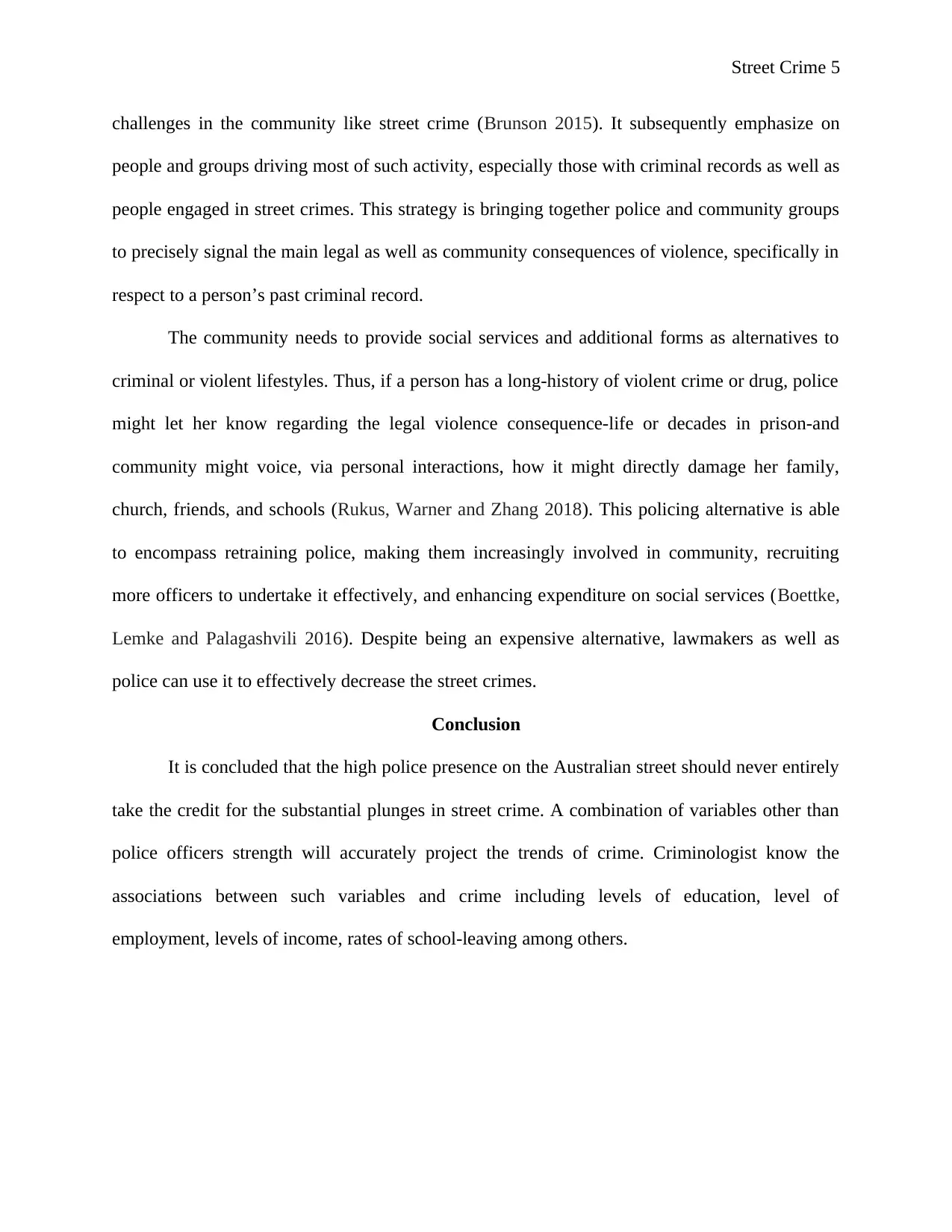
Street Crime 5
challenges in the community like street crime (Brunson 2015). It subsequently emphasize on
people and groups driving most of such activity, especially those with criminal records as well as
people engaged in street crimes. This strategy is bringing together police and community groups
to precisely signal the main legal as well as community consequences of violence, specifically in
respect to a person’s past criminal record.
The community needs to provide social services and additional forms as alternatives to
criminal or violent lifestyles. Thus, if a person has a long-history of violent crime or drug, police
might let her know regarding the legal violence consequence-life or decades in prison-and
community might voice, via personal interactions, how it might directly damage her family,
church, friends, and schools (Rukus, Warner and Zhang 2018). This policing alternative is able
to encompass retraining police, making them increasingly involved in community, recruiting
more officers to undertake it effectively, and enhancing expenditure on social services (Boettke,
Lemke and Palagashvili 2016). Despite being an expensive alternative, lawmakers as well as
police can use it to effectively decrease the street crimes.
Conclusion
It is concluded that the high police presence on the Australian street should never entirely
take the credit for the substantial plunges in street crime. A combination of variables other than
police officers strength will accurately project the trends of crime. Criminologist know the
associations between such variables and crime including levels of education, level of
employment, levels of income, rates of school-leaving among others.
challenges in the community like street crime (Brunson 2015). It subsequently emphasize on
people and groups driving most of such activity, especially those with criminal records as well as
people engaged in street crimes. This strategy is bringing together police and community groups
to precisely signal the main legal as well as community consequences of violence, specifically in
respect to a person’s past criminal record.
The community needs to provide social services and additional forms as alternatives to
criminal or violent lifestyles. Thus, if a person has a long-history of violent crime or drug, police
might let her know regarding the legal violence consequence-life or decades in prison-and
community might voice, via personal interactions, how it might directly damage her family,
church, friends, and schools (Rukus, Warner and Zhang 2018). This policing alternative is able
to encompass retraining police, making them increasingly involved in community, recruiting
more officers to undertake it effectively, and enhancing expenditure on social services (Boettke,
Lemke and Palagashvili 2016). Despite being an expensive alternative, lawmakers as well as
police can use it to effectively decrease the street crimes.
Conclusion
It is concluded that the high police presence on the Australian street should never entirely
take the credit for the substantial plunges in street crime. A combination of variables other than
police officers strength will accurately project the trends of crime. Criminologist know the
associations between such variables and crime including levels of education, level of
employment, levels of income, rates of school-leaving among others.
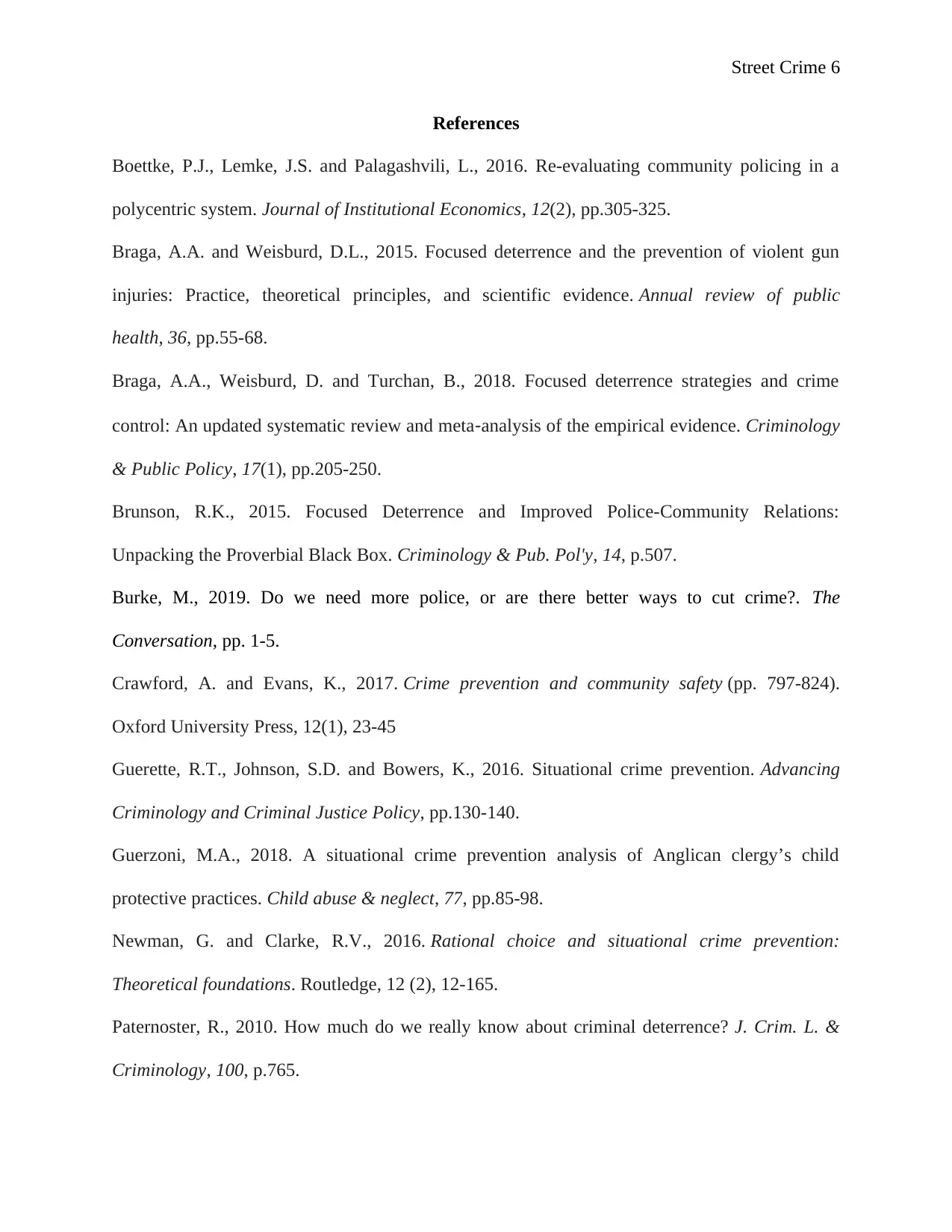
Street Crime 6
References
Boettke, P.J., Lemke, J.S. and Palagashvili, L., 2016. Re-evaluating community policing in a
polycentric system. Journal of Institutional Economics, 12(2), pp.305-325.
Braga, A.A. and Weisburd, D.L., 2015. Focused deterrence and the prevention of violent gun
injuries: Practice, theoretical principles, and scientific evidence. Annual review of public
health, 36, pp.55-68.
Braga, A.A., Weisburd, D. and Turchan, B., 2018. Focused deterrence strategies and crime
control: An updated systematic review and meta‐analysis of the empirical evidence. Criminology
& Public Policy, 17(1), pp.205-250.
Brunson, R.K., 2015. Focused Deterrence and Improved Police-Community Relations:
Unpacking the Proverbial Black Box. Criminology & Pub. Pol'y, 14, p.507.
Burke, M., 2019. Do we need more police, or are there better ways to cut crime?. The
Conversation, pp. 1-5.
Crawford, A. and Evans, K., 2017. Crime prevention and community safety (pp. 797-824).
Oxford University Press, 12(1), 23-45
Guerette, R.T., Johnson, S.D. and Bowers, K., 2016. Situational crime prevention. Advancing
Criminology and Criminal Justice Policy, pp.130-140.
Guerzoni, M.A., 2018. A situational crime prevention analysis of Anglican clergy’s child
protective practices. Child abuse & neglect, 77, pp.85-98.
Newman, G. and Clarke, R.V., 2016. Rational choice and situational crime prevention:
Theoretical foundations. Routledge, 12 (2), 12-165.
Paternoster, R., 2010. How much do we really know about criminal deterrence? J. Crim. L. &
Criminology, 100, p.765.
References
Boettke, P.J., Lemke, J.S. and Palagashvili, L., 2016. Re-evaluating community policing in a
polycentric system. Journal of Institutional Economics, 12(2), pp.305-325.
Braga, A.A. and Weisburd, D.L., 2015. Focused deterrence and the prevention of violent gun
injuries: Practice, theoretical principles, and scientific evidence. Annual review of public
health, 36, pp.55-68.
Braga, A.A., Weisburd, D. and Turchan, B., 2018. Focused deterrence strategies and crime
control: An updated systematic review and meta‐analysis of the empirical evidence. Criminology
& Public Policy, 17(1), pp.205-250.
Brunson, R.K., 2015. Focused Deterrence and Improved Police-Community Relations:
Unpacking the Proverbial Black Box. Criminology & Pub. Pol'y, 14, p.507.
Burke, M., 2019. Do we need more police, or are there better ways to cut crime?. The
Conversation, pp. 1-5.
Crawford, A. and Evans, K., 2017. Crime prevention and community safety (pp. 797-824).
Oxford University Press, 12(1), 23-45
Guerette, R.T., Johnson, S.D. and Bowers, K., 2016. Situational crime prevention. Advancing
Criminology and Criminal Justice Policy, pp.130-140.
Guerzoni, M.A., 2018. A situational crime prevention analysis of Anglican clergy’s child
protective practices. Child abuse & neglect, 77, pp.85-98.
Newman, G. and Clarke, R.V., 2016. Rational choice and situational crime prevention:
Theoretical foundations. Routledge, 12 (2), 12-165.
Paternoster, R., 2010. How much do we really know about criminal deterrence? J. Crim. L. &
Criminology, 100, p.765.
⊘ This is a preview!⊘
Do you want full access?
Subscribe today to unlock all pages.

Trusted by 1+ million students worldwide
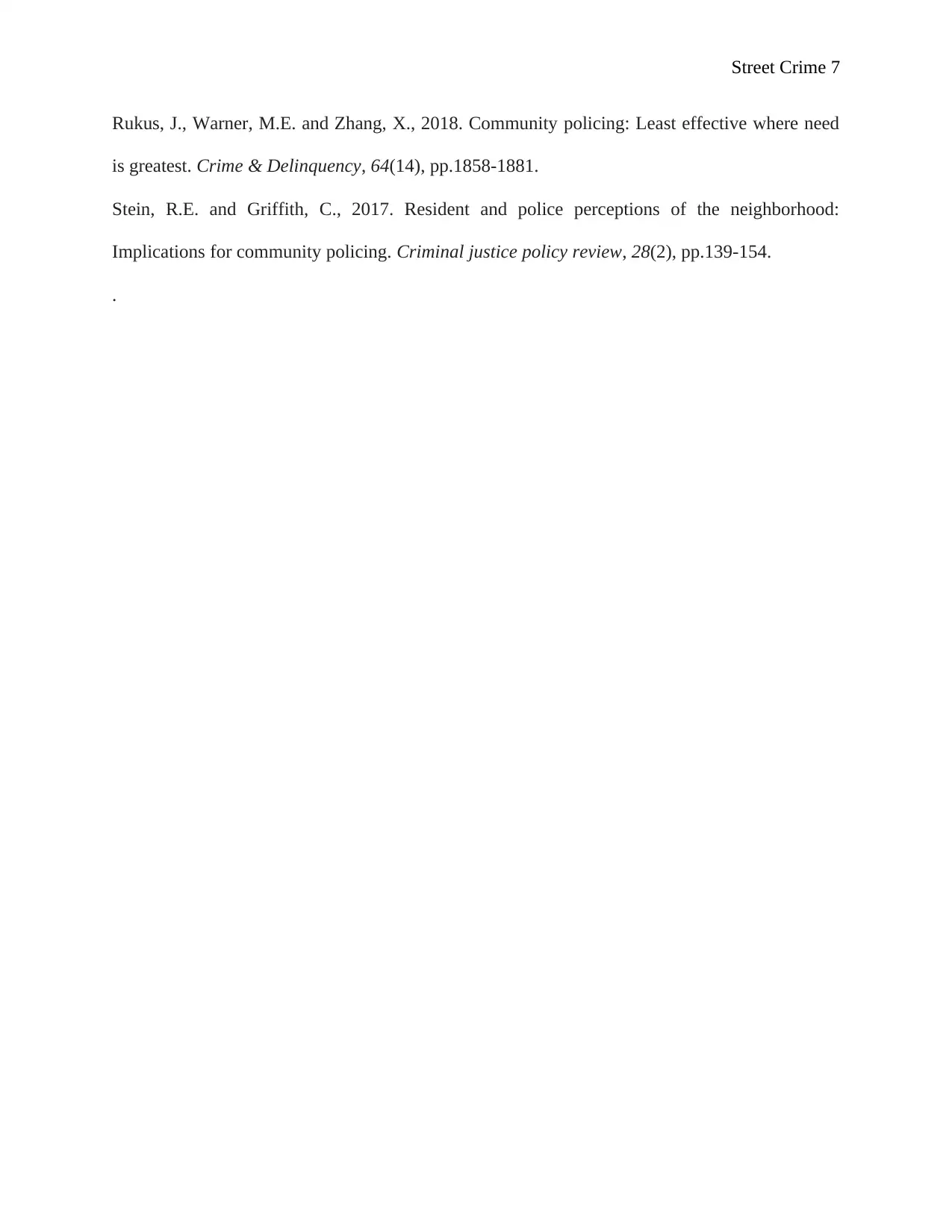
Street Crime 7
Rukus, J., Warner, M.E. and Zhang, X., 2018. Community policing: Least effective where need
is greatest. Crime & Delinquency, 64(14), pp.1858-1881.
Stein, R.E. and Griffith, C., 2017. Resident and police perceptions of the neighborhood:
Implications for community policing. Criminal justice policy review, 28(2), pp.139-154.
.
Rukus, J., Warner, M.E. and Zhang, X., 2018. Community policing: Least effective where need
is greatest. Crime & Delinquency, 64(14), pp.1858-1881.
Stein, R.E. and Griffith, C., 2017. Resident and police perceptions of the neighborhood:
Implications for community policing. Criminal justice policy review, 28(2), pp.139-154.
.
1 out of 7
Your All-in-One AI-Powered Toolkit for Academic Success.
+13062052269
info@desklib.com
Available 24*7 on WhatsApp / Email
![[object Object]](/_next/static/media/star-bottom.7253800d.svg)
Unlock your academic potential
Copyright © 2020–2025 A2Z Services. All Rights Reserved. Developed and managed by ZUCOL.
